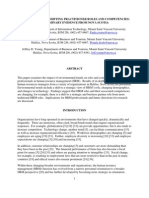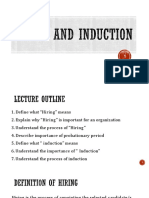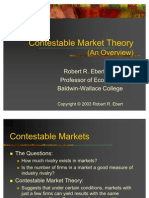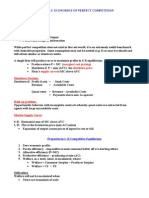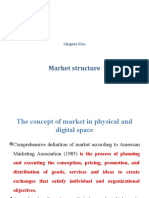0 ratings0% found this document useful (0 votes)
183 viewsContestable Market
Contestable Market
Uploaded by
Anna NgThis document defines and discusses the concept of a contestable market. A contestable market is one where there is free entry and exit of firms, with low or zero sunk costs. For a market to be perfectly contestable, sunk costs would be zero and new and incumbent firms would face similar costs, eliminating any competitive advantage of incumbents. The theory is that even without actual new entry or competition, the mere threat of entry and exit is enough to force firms to behave efficiently and not abuse their market power. Making markets more contestable is one way to promote competition without direct government intervention.
Copyright:
© All Rights Reserved
Available Formats
Download as PDF, TXT or read online from Scribd
Contestable Market
Contestable Market
Uploaded by
Anna Ng0 ratings0% found this document useful (0 votes)
183 views5 pagesThis document defines and discusses the concept of a contestable market. A contestable market is one where there is free entry and exit of firms, with low or zero sunk costs. For a market to be perfectly contestable, sunk costs would be zero and new and incumbent firms would face similar costs, eliminating any competitive advantage of incumbents. The theory is that even without actual new entry or competition, the mere threat of entry and exit is enough to force firms to behave efficiently and not abuse their market power. Making markets more contestable is one way to promote competition without direct government intervention.
Original Description:
What is contestable market and the example
Copyright
© © All Rights Reserved
Available Formats
PDF, TXT or read online from Scribd
Share this document
Did you find this document useful?
Is this content inappropriate?
This document defines and discusses the concept of a contestable market. A contestable market is one where there is free entry and exit of firms, with low or zero sunk costs. For a market to be perfectly contestable, sunk costs would be zero and new and incumbent firms would face similar costs, eliminating any competitive advantage of incumbents. The theory is that even without actual new entry or competition, the mere threat of entry and exit is enough to force firms to behave efficiently and not abuse their market power. Making markets more contestable is one way to promote competition without direct government intervention.
Copyright:
© All Rights Reserved
Available Formats
Download as PDF, TXT or read online from Scribd
Download as pdf or txt
0 ratings0% found this document useful (0 votes)
183 views5 pagesContestable Market
Contestable Market
Uploaded by
Anna NgThis document defines and discusses the concept of a contestable market. A contestable market is one where there is free entry and exit of firms, with low or zero sunk costs. For a market to be perfectly contestable, sunk costs would be zero and new and incumbent firms would face similar costs, eliminating any competitive advantage of incumbents. The theory is that even without actual new entry or competition, the mere threat of entry and exit is enough to force firms to behave efficiently and not abuse their market power. Making markets more contestable is one way to promote competition without direct government intervention.
Copyright:
© All Rights Reserved
Available Formats
Download as PDF, TXT or read online from Scribd
Download as pdf or txt
You are on page 1of 5
Contestable Markets
What is a Contestable Market?
Contestability is not only about barriers to entry but also about the ease of exit
from the industry
In a perfectly contestable market sunk costs would be zero
Contestability is not necessarily about minimising all barriers; it is more about
existing and new firms facing similar costs so incumbent firms have no
competitive advantage over new entrants
The theory is that new entrants and competition is not necessary to make firms
behave in ways which maximise welfare
(productive efficiency working at bottom of ATC curve,
allocative efficiency where AR=MC)
all that is needed is the THREAT of new entrants
Therefore making markets more contestable is one way to combat the abuse of
market power
Contestable Market: where there is free entry and free exit of other firms
Example
Oxford Walking Tours
Contestable Market:
where there is free entry
and free exit of other
firms
Ease of exit sunk costs
Similar costs for new
entrants and incumbents
New entrant
Incumbent
response
Diagram: Extreme Contestability
Perfect Contestability: unlikely in
reality, but close to is achievable
Imperfect competition downward
sloping D curve
Resembles perfect competition
productive and allocative efficiency is
achieved
Normal profits are made AR=AC
There is no need for the government
to intervene in this market
efficiency is achieved through
contestability!
Sunk Costs: sunk costs are retrospective (past) costs that have
already been incurred and cannot be recovered e.g.
advertising
Hit and Run Entry: where new firms enter the industry, cream
off some of the supernormal profits of the incumbents and
then exit
Key Definitions
You might also like
- Teneo Vision 2023 CEO Investor SurveyDocument30 pagesTeneo Vision 2023 CEO Investor Surveyدحوم ..No ratings yet
- ExplanationDocument2 pagesExplanationBenedict OnyangoNo ratings yet
- Salesperson Performance: Behavior, Role Perceptions, and SatisfactionDocument25 pagesSalesperson Performance: Behavior, Role Perceptions, and SatisfactionShradha GuptaNo ratings yet
- Module 3 ScenarioDocument2 pagesModule 3 ScenarioBenedict OnyangoNo ratings yet
- Ch07 PDFDocument14 pagesCh07 PDFVina100% (1)
- The Impact of Government Spending On Economic GrowthDocument18 pagesThe Impact of Government Spending On Economic GrowthFloripondio19No ratings yet
- Tan Sri Syed Mokhtar Al Bukhary-AssignmentDocument4 pagesTan Sri Syed Mokhtar Al Bukhary-AssignmentPendy Fendy100% (2)
- Barriers of Tenaga NasionalDocument2 pagesBarriers of Tenaga NasionalTae's WifeuNo ratings yet
- Strategic ManagementDocument34 pagesStrategic ManagementDewi PuspitaNo ratings yet
- Scorecard-Credit Card CompanyDocument1 pageScorecard-Credit Card CompanyEtrie Vanelia PutriNo ratings yet
- Accenture 1Document16 pagesAccenture 1Somya Sekhar DashNo ratings yet
- M12 Wage & Salary AdministrationDocument52 pagesM12 Wage & Salary Administrationleahhanbin100% (1)
- BSC of Regional AirlineDocument1 pageBSC of Regional AirlineFaisal IqbalNo ratings yet
- 06 Push Pull StrategiesDocument14 pages06 Push Pull Strategieslencerti100% (1)
- Compensation Strategies and PracticesDocument33 pagesCompensation Strategies and PracticesHani ZahraNo ratings yet
- Talent Management FrameworkDocument16 pagesTalent Management FrameworkTuongPhanNo ratings yet
- Analysis of Human Capital Development in Puerto RicoDocument27 pagesAnalysis of Human Capital Development in Puerto RicoMohamad Shahhanaz NazarudinNo ratings yet
- 4 Daft Mngt13e PPT Ch04Document30 pages4 Daft Mngt13e PPT Ch04Stanley CkNo ratings yet
- Organisational EffectivenessDocument18 pagesOrganisational Effectivenessvinayaksajan100% (1)
- CL Unilever Organizational Changes in INMARKO ENGDocument28 pagesCL Unilever Organizational Changes in INMARKO ENGRajkumar35No ratings yet
- GD Express Carrier VS Pos Malaysian BerhadDocument9 pagesGD Express Carrier VS Pos Malaysian BerhadZian DouglasNo ratings yet
- Group3 SemiconIndiaDocument12 pagesGroup3 SemiconIndiaSULOCHNA KUJURNo ratings yet
- 3b Recruitment and SelectionDocument19 pages3b Recruitment and SelectionManishNo ratings yet
- Creating HR Service Delivery Success: HRO Today Forum Europe 2012Document22 pagesCreating HR Service Delivery Success: HRO Today Forum Europe 2012Ohiwei OsawemenNo ratings yet
- Work Design Has Been Researched and Applied Extensively in OrganizationsDocument21 pagesWork Design Has Been Researched and Applied Extensively in OrganizationsRimsha Noor ChaudaryNo ratings yet
- Syllabus Bolton UniversityDocument5 pagesSyllabus Bolton UniversityPhuongChiNo ratings yet
- Approaches To International CompensationDocument20 pagesApproaches To International CompensationDhwani Shah100% (4)
- CLDM Project Guidelines at Version 5.2, February 2017Document22 pagesCLDM Project Guidelines at Version 5.2, February 2017GPNo ratings yet
- Cross 1988Document11 pagesCross 1988deltanueveNo ratings yet
- Crafting and Executing Strategy Core ConceptsDocument5 pagesCrafting and Executing Strategy Core ConceptsKCSNo ratings yet
- Managing Competencies With SoftwareDocument3 pagesManaging Competencies With SoftwareJeeNo ratings yet
- Chapter 2 Job Analysis and EvaluationDocument28 pagesChapter 2 Job Analysis and EvaluationRhaylyn AranasNo ratings yet
- HRM Changing TrendsDocument13 pagesHRM Changing TrendsJay ModyNo ratings yet
- Interview Questions To Assess Competencies 863Document5 pagesInterview Questions To Assess Competencies 863shaj.kurian64660% (1)
- Deep Change Referee ReportDocument3 pagesDeep Change Referee ReportMadridista KroosNo ratings yet
- Hiring and InductionDocument22 pagesHiring and InductionSupun KumaraNo ratings yet
- How Netflix Reinvented HR: by Patty MccordDocument20 pagesHow Netflix Reinvented HR: by Patty MccordRevah IbrahimNo ratings yet
- HR Polices of UfoneDocument30 pagesHR Polices of UfoneArsalanAliRajaNo ratings yet
- Executive CompensationDocument18 pagesExecutive Compensationnomi1975No ratings yet
- HR-2013-004 Compensation & Benefits & HR Policies SpecialistDocument3 pagesHR-2013-004 Compensation & Benefits & HR Policies Specialistsadir160% (1)
- Optional Ch-14-S-Designing and Managing ServicesDocument6 pagesOptional Ch-14-S-Designing and Managing ServicesFoigeNo ratings yet
- Ramco HCMDocument38 pagesRamco HCMLINKAN_SINGH4102No ratings yet
- Chapter-01 (Pay Model) )Document35 pagesChapter-01 (Pay Model) )Rahat KhanNo ratings yet
- Corporate ParentingDocument4 pagesCorporate ParentingGyan Singh100% (2)
- Crafting A Business Plan and Building A Solid Strategic PlanDocument29 pagesCrafting A Business Plan and Building A Solid Strategic PlanNusrat IslamNo ratings yet
- Performance Management System PhilosophyDocument8 pagesPerformance Management System PhilosophyGency0511No ratings yet
- A Report On Business CommunicationDocument22 pagesA Report On Business Communicationarjbaid100% (1)
- Leading The Process of Crafting and Executing StrategyDocument27 pagesLeading The Process of Crafting and Executing StrategySifat Shahriar ShakilNo ratings yet
- Accenture FinalDocument7 pagesAccenture FinalFlori May Casakit100% (1)
- Summative Assessment Brief - Global Strategy and SustainabilityDocument9 pagesSummative Assessment Brief - Global Strategy and SustainabilityFarhan Ali0% (1)
- Ethics in FinanceDocument13 pagesEthics in FinanceDheeraj ShriyanNo ratings yet
- Contestable Market TheoryDocument12 pagesContestable Market TheoryGulsehar SabriNo ratings yet
- Chapter 3: Economics of Perfect Competition: Marginal Cost Pricing Shutdown Price Supply Curve Shutdown DecisionDocument4 pagesChapter 3: Economics of Perfect Competition: Marginal Cost Pricing Shutdown Price Supply Curve Shutdown DecisionArina Farihan AzharNo ratings yet
- Market Structure: Chapter FiveDocument22 pagesMarket Structure: Chapter FiveOromay EliasNo ratings yet
- Managerial Economics & Business StrategyDocument31 pagesManagerial Economics & Business StrategyYokie RadnanNo ratings yet
- Competition & Pure MonopolyDocument36 pagesCompetition & Pure MonopolyChadi AboukrrroumNo ratings yet
- Contestable MarketsDocument4 pagesContestable MarketsmoyoninuoluwaokeowoNo ratings yet
- Unit VII Pricing and Output Decisions: Perfect Competition and MonopolyDocument36 pagesUnit VII Pricing and Output Decisions: Perfect Competition and MonopolyIshan PalNo ratings yet
- Contestable MarketsDocument13 pagesContestable MarketsAnotida MagwenziNo ratings yet
- The Market Makers (Review and Analysis of Spluber's Book)From EverandThe Market Makers (Review and Analysis of Spluber's Book)No ratings yet
- Economics and Finance 2. Sem: Mo Di Mi Do FR Sa 1Document1 pageEconomics and Finance 2. Sem: Mo Di Mi Do FR Sa 1Anna NgNo ratings yet
- Get Me Throug H Decem Ber Natalie Macm Aster: Rhythm of Love Hey There DelilahDocument1 pageGet Me Throug H Decem Ber Natalie Macm Aster: Rhythm of Love Hey There DelilahAnna NgNo ratings yet
- TL ModulhandbuchDocument78 pagesTL ModulhandbuchAnna NgNo ratings yet
- Infinitiv Präteritum (Preterite) Perfekt (Past Participle) : AnfangenDocument8 pagesInfinitiv Präteritum (Preterite) Perfekt (Past Participle) : AnfangenAnna NgNo ratings yet
































